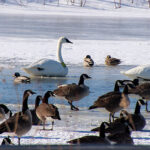When you think of December, you think of Christmas or Hanukkah, right? But, have you ever heard of Yule? Of course, you’ve heard “yule,” in Christmas carols and songs like, “Deck the Halls” and “Have Yourself a Merry Little Christmas,” but do you know what Yule is? Yule is celebrated on the Winter Solstice, or December 21st, with festivities beginning on December 20th and ending on December 23rd. Yule is derived from the Norse word Iul, which means “wheel.”
What is Yule exactly? Yule is the time of year when the Moon Goddess gives birth to the Sun God, signifying the beginning of a new year, with the year having ended on Samhain, more commonly known as Halloween. Yule is essentially a festival of light, as well as a precursor to a time of quiet, as the Winter Solstice is the shortest day, and the longest night, of the year. In 273 C.E. (Common Era), Christians adopted this time of year to repurpose it as their own, and to draw people of the Old Religion, Pagans, away from their own. This time also coincides with wreaths, Christmas trees, and caroling, surprisingly.
Yule is celebrated by Neopagans, or as we call ourselves, Pagans. There are multiple branches of Paganism, as well as subcategories for each branch. One such branch is Wicca. Wicca is a modern Pagan religion, getting its name from Old English’s term for ‘witch,’ and was coined as a term for a Pagan branch in the 1950s. Wicca has multiple celebrations per year, Yule being one of them.
But what exactly do Wiccans do at Yule? As Yule is a festival of light, Wiccans light candles and fires to welcome the sun’s return, bringing light back into the world. With the burning of fires, Wiccans collect and burn what is called a “Yule log.” Yule logs were put into a fire by one end and burned to the other end. The remaining end was kept carefully, and was believed that it brought protection against fire and lightning to the home. There are rituals, but they depend on the branch of Paganism. In one of my spell books, I found a Yule Good Luck Charm, which utilizes the ashes of the Yule log. The Yule Good Luck Charm has primarily the one purpose—bring good luck. But one thing is different: the wish. In the Good Luck Charm, you put a slip of paper into the good luck charm with an individualized wish of good luck to whomever you’re giving it to, meaning, that, even though each Good Luck Charm looks the same, they are personal all the same.
Yule is the quiet beginning of a new year. As the Moon Goddess rests, the winter settles in. We await the melting of the snow, bringing about warmth and sun. Wicca is not something to take lightly, nor are its holidays. Whether I taught you something new and opened your eyes up to a new practice, or you learned more about something you’ve heard of before, it’s important to note that I am just one Wiccan. The way I celebrate may not be the way others celebrate, and that’s okay. We don’t all have to celebrate a holiday the same way, but it feels good to be in the company of those who do. Don’t forget to celebrate whichever holiday you celebrate with your loved ones. Happy Holidays! Blessed be!

Categories: Editorials, Opinion










